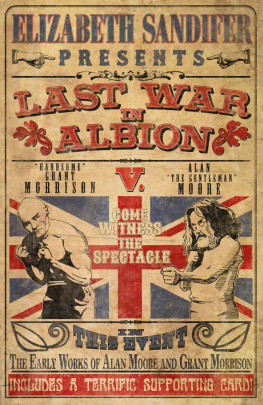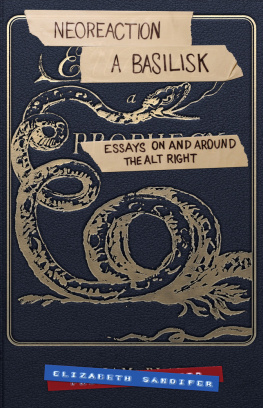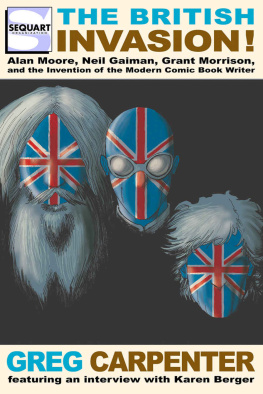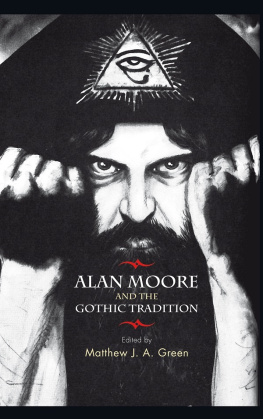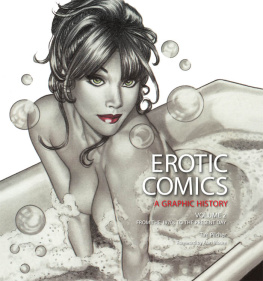The Last War in Albion Volume 1: The Early Work of Alan Moore and Grant Morrison
Elizabeth Sandifer

Copyright 2016, 2019 Elizabeth Sandifer
Published by Eruditorum Press
All rights reserved.
To Ahania
Table of Contents
Prologue
This is not a dream.
Alan Moore, Shadowplay, in Brought to Light , 1988.
IMPORTANT NOTE: The authors intended version of this book contains 210 fair use and public domain images as befits its profoundly visual subject matter. For a variety of deeply boring reasons, it is impossible to distribute this ebook via traditional sales channels with those images without increasing the price beyond what is fair. At the end of the book you will find a url where you can download a version of the book with images free of charge. Doing so is highly recommended.
The Last War in Albion is a history of British comics. More specifically, it is a history of the magical war between Grant Morrison and Alan Moore, a war that is on the one hand entirely of its own invention and on the other a war fought in the realm of the fictional, rendering its actual existence almost but not entirely irrelevant. Certainly the unreality of the War has not stopped it from being the most fundamental battle for the soul of Britain in the isles long history of magical warfare.
The War, to be clear, is not the scant material residue of their verbal feud in various interviews over the years; this exists and will be picked over, but it is not the meat of the matter. Rather it is a more basic issue: how is it that two comics writers with such a clear overlap in interests, who grew up a mere three-hundred-and-forty miles (no further than from Boston to Washington) and seven years (no larger than the age difference between J.R.R. Tolkien and C.S. Lewis) apart are not friends and have not a hint of warmth in their relationship? And yet it is emphatically and undeniably the case.
Underneath this fact is a story: one of how the British comics industry unexpectedly produced a small generation of some of the most important writers of the 1980s and 90s, and in turn had a huge cultural legacy in both the US and UK. So much so that the number three grossing movie of all time, Joss Whedons The Avengers , is massively and documentably indebted to a British comics industry that was, prior to the arrival of people like Alan Moore, Grant Morrison, Neil Gaiman, Warren Ellis, and Kieron Gillen, a minor backwater of the lowest order.
Within that story there are two figures that appear almost identical to even a casual observer. One, Alan Moore, is a heavily bearded self-proclaimed magician who made his name with DC Comics in 1984 writing Swamp Thing , an environmental-themed superhero-horror comic. The other, Grant Morrison, is a bald self-proclaimed magician who made his name with DC Comics in 1988 writing Animal Man , an environmental-themed superhero-horror comic. As has been mentioned, these two men are not friends. Indeed, to be blunt, they hate each others guts. There are sensible reasons for this. Despite their intense similarities, there are fundamental aesthetic differences between Grant Morrison and Alan Moore that place them in diametric opposition for a host of issues with profound social, political, historical, and magical implications.
This latter adjective is worth remarking upon, as it is central to their differences. Both men believe in a system by which the manipulation of symbols creates material change in the real world. Both explicitly use their creative work in multiple media as an attempt to cause such change. Their comics are magic spells hurled into the culture wars, trying in their own way to reshape reality. And they are opposed. This is the story of what happens as a result of this. This is the story of the Last War in Albion.
Understanding this event as a war has several consequences. It does not entirely mean that it is a story of two generals marshalling their forces and battling on the astral plane. It is not Harry Potter versus Voldemort (more Hagrid versus Snape, really). Alan Moore and Grant Morrison are combatants, and major battles revolve around their actions, but their role is that of Austria and Serbia in World War I. The actual war is much larger and diffuse, its reach spiraling outwards through Ideaspace such that few things are left undisturbed by its fallout.
Nevertheless, The Last War in Albion will approach the War primarily through the lens of its outbreak and initial combatants: Alan Moore and Grant Morrison. The mildly hostile interplay of their entwined careers will be understood as the beginning of its story. There is, of course, backstory and foreshadowing to be had, but how it chronologically plays out from 1978 to the present day forms the primary plot, if you will, of the project. It is in this regard comparable to Neal Stephensons treatment of the Newton-Leibnitz feud in The Baroque Cycle , his three-thousand-page magnum opus. Except this will probably be longer.
The structure of The Last War in Albion is self-consciously different from TARDIS Eruditorum , the project to which it is most obviously compared. That project is structured as an episode guidea series of short essays on successive episodes of Doctor Who . The Last War in Albion was, at least initially, structured as a single essay, and though this collected edition has been subdivided into chapters for convenience, the overall logic of ongoing serialized narrativea form central to the War itselfhas been retained.
This means that it does not linearly cover every Grant Morrison and Alan Moore comic in publication order with distinct entries for each, although as near to every comic by both writers (as well as, in later volumes, several others) as it is feasible to discuss will be discussed. Rather, it will take longer and more oblique paths. It will inevitably return to the basic narrative of 1978 to the present day, but as the word return suggests, it will depart from the main thoroughfare regularly. A section talking about a seven-page comic in an anthology may be followed by one talking about 1960s new wave science fiction, followed by one about 1973 trash cinema, followed by one about a different comic published off and on from the year of the seven-pager to 1989, followed by one about William Blake, before finally moving on to the original writers other major comics work of that year, a forgotten superhero strip for his local paper. And all of these sections may be internally digressive as well, gesturing towards other sections of the book or of future books.
The remaining nature of the War will be revealed in the telling. All that remains is the task of selecting a beginning point and commencing the narrative proper.
Chapter One: Near Myths
To leap from one universe to another, unafraid! Thats sorcerers work!
Grant Morrison, Zatanna #1, 2005
By virtue of one of the major figures being extremely invested in the precise timing of it, that beginning point will be the publication of Grant Morrisons first paid comics work, a five-page story entitled Time is a Four Letter Word published in a short-lived Scottish anthology called Near Myths in October 1978. This is a decision with consequences. The nature of the War, as previously stated, is that its effects span much of history. Time is a Four Letter Word is akin to an outcrop of rock, and a seemingly tiny one at that. In truth, however, it stands upon tens of miles of buried rocka geologic strata spanning in every direction. The visible layer is a mere fraction of the whole, apparent only due to chance events: the scouring of a glacier, the cleaving of a river valley, an editor picking up a particular story from the slush pile. These fleeting circumstances determine how the underlying tectonics of history and ideology are transmuted into surface terrain and material culture, defining the very world itself.
Next page
